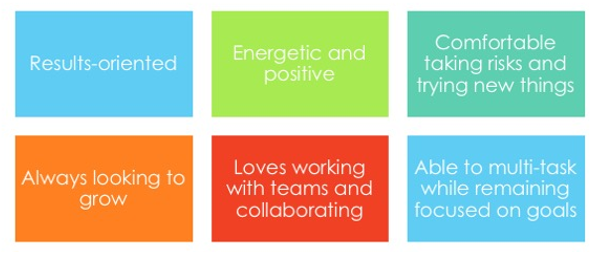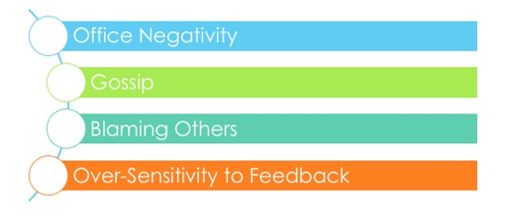Welcome to
Lead Motivate and Inspire your Dream TeamGuide a team the right way to achieve your business goals
Module One
Create a Culture of Collaboration and Innovation
Whether you’re a small business with a handful of employees or a mid-sized and growing company with 50 to 100, creating a culture that nurtures collaboration and innovation is essential for building a high-performing team that supports and drives your results. In this module, you’ll learn tips for hiring the right people to include in your team in the first place, and simple strategies for encouraging an environment where innovation will flourish.
Hiring the Right People
No matter what kind of team you’re building and what hard skills are required, there are certain qualities that are universal for building an innovative team.
The qualities you should look for are:

- Results-oriented
- Energetic and positive
- Comfortable taking risks and trying new things
- Always looking to grow
- Loves working with teams and collaborating
- Able to multi-task while remaining focused on goals
How do you know that your potential hires possess these qualities? Take some time to create interview questions that would reveal this. Examples might be:
- “You’re on your way to the first meeting of a new project team. What questions are on your mind?”
- “Is it possible to be a good team player and still disagree with your manager?”
- “When was a time you failed to achieve your goals. What did you learn or what was the result?”
- “You have to work in multi-person teams at one time. How do you change your approach from one to another?”
These are a few examples of general questions, but another way to create good interview questions is to ask your potential hires for examples where they exhibited the above traits. For example, as them about how they used positivity to overcome a difficulty or ask them about specific results they’ve achieved.
When contacting your applicants’ references, also ask them about the above traits and try to get specific examples wherever possible.
Creating a Culture of Innovation
If you already have your team formed, you can train and coach your team members to become more entrepreneurial, but it takes some time and energy. The result, however, is a culture of innovation where the creativity comes naturally.
To create this culture of innovation, start by making a list of the characteristics you’re looking for. Show this list to your team members and discuss these characteristics. Ask them how they think you could foster these characteristics as a team.
Make sure that the meeting is not top-down. Your mission is to gain the input of your team members. Get their feedback and listen to their ideas. Try to leave the meeting with some ideas you can implement and test out. Envision how these characteristics would look when implemented in the workplace.
If you want to change your own leadership style to suit these characteristics, discuss this with your team too. Be transparent about how you’re planning to make these changes.
A good way to reinforce these qualities is to represent them visually. If you have a physical location for your team, such as an office, create posters or have your team members create posters. Put these up around common areas.
If your team is mostly virtual, you can create digital posters and have your team members print them out and post them in their home offices. You can also create mouse pads, screen savers, and other visual products that represent these concepts.
One good way to make visuals is to use quotes. Choose quotes from the internet that embody or inspire the cultural values you’re aiming for. You can add quotes to your email signature, create memes or other visuals with them, and use them in your posters or other materials.
Create a program to reinforce these cultural values. During your team meetings, whether in-person or virtually, add an agenda item dedicated to recognizing these behaviors. Recognize team members and encourage your members to recognize each other. This helps to reinforce your values and keep them on the forefront of everyone’s mind.
Consider some way to reward the behaviors you’re aiming to develop. For example, you might offer a free lunch of gift card, or even just a shout out on social media. You can give away office perks like a good parking spot. For virtual members, offer gift cards or ecards.
The key to successfully implementing your desired values is to walk the walk yourself. You must embody the values you expect your team members to adopt. If you come across as fake to your team, this type of culture program can implode.
Since it takes time and energy to build your team’s culture, set aside time in your schedule for working on it. You’ll need space to think about your culture, but also plan and implement. We’ll talk about ways to implement in the next two modules.
Culture Killers
There are a few behaviors that can kill any attempt at creating a new, more innovative culture.
Office Negativity – It’s okay to have a bad day from time to time. Everyone in the office can’t be happy all of the time. But when office negativity rears its ugly head, you need to handle it quickly and resolve every member’s issues so that everyone can function with a clear head.
Gossip – Gossip is often an issue with physical offices. Office gossip splits teams into factions and turns team member against each other. It also distracts team members and can lead to office negativity. Discourage gossip when you hear about it and, if there’s a legitimate issue going on, raise it with the team – without naming specific people.
Blaming Others – Blaming is a serious culture killer. The symptoms of blaming include arguing over responsibilities, individual team members contacting you about others, or team members directly blaming each other. A good way to prevent this is to reinforce the idea that everyone plays an important role in achieving your goals, and that mistakes are not to be feared. It also helps if you set the example yourself by taking responsibility for your own failures and mistakes.
Over-Sensitivity to Feedback – If team members are overly sensitive to feedback, they’ll be less likely to share their ideas. Create an environment where feedback is given in a positive way and, again, reinforce that there are no mistakes and failures.

With virtual teams, negative behaviors are generally less of an issue. One way to reduce office politics or issues is to encourage your employees to work remotely or work at home during specific times. In fact, you can ask them only to come when there is a specific meeting or event. We’ll look at further ways to address and reinforce appropriate behaviors in the coaching module as well.
Activity:
- Make a list of attributes you are looking for in your team members. Build from the list that was provided at the beginning of this module.
- Create some interview questions that address these attributes so you’ll have them handy the next time you are hiring someone.
- From the list of suggested approaches to build an innovative and collaborative culture, pick 3 ideas that you can implement right away. Alternatively, if you have your own ideas, use those.
- What kind of negative behaviors do you have among your team members that you’d like to address? Write down a few ways you will address them.
Handouts and Planning Sheets
Bonus Materials
Cracking the Rich Code
"Whether you’ve been stuck on the sidelines waiting for the “right time” to launch your business or struggling to “generate” the life changing results from your business- This is your time to start saying “YES” to opportunity and “NO” to the noise. 100% of us entrepreneurs need answers and solutions. Join me to get updated on what it takes to prepare yourself and stay ahead of this changing business world."

Our superpower is making you a superhero.



